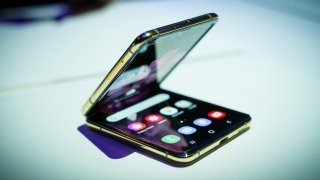
What to Know
- At Galaxy Unpacked 2020 in San Francisco, Samsung took the wraps of the folding Galaxy Z Flip, a clamshell-style phone featuring a bendable glass display
- Samsung also introduced the Galaxy S20 range of phones, including an "Ultra" model with a 108-megapixel main camera and 10x optical zoom
- The Galaxy Z Flip will launch on Valentine's Day, while the S20 series will become available in early March
Just like fanny packs and high-waisted jeans, another 1990s trend is trying to make a fierce comeback: flip phones.
At its annual Samsung Galaxy Unpacked event, held this year at San Francisco's Palace of Fine Arts, the world's largest smartphone maker took the wraps off its heavily-rumored Galaxy Z Flip, a smartphone that folds in half like a clamshell, and opens to reveal a seamless OLED display.
With a $1,380 price tag, the Galaxy Z Flip isn't intended for everyone. It's a design-forward phone, available in just one storage configuration (256GB, with 8GB RAM) that comes in black and purple in the U.S., plus a limited gold edition in select other countries. An ultra-exclusive Thom Browne edition, with red, white and blue racing stripes, will make its debut during New York Fashion Week.
Samsung makes full use of the folding display in both its open-flat and half-open configurations. Opened to 90 or 130 degrees, the phone acts a bit like a laptop, with apps that support it displaying video or photo content on the upper half of display, and controls and navigation on the lower half. When fully closed, a tiny color display on the outside of the phone can be used to frame selfies (though there's also a dedicated selfie camera inside).
Though the Galaxy Z Flip occupied the first spot in Samsung's hour-long keynote — and occupied gaggles of photographers for two hours after it — the Galaxy S20 also made its debut at this event, bringing 5G and impressive new camera specs to Samsung's flagship mobile device.
The sequel to the Galaxy S10 — Samsung made waves in the tech media by skipping over the numbers 11 through 19 — the Galaxy S20 will arrive in early March along with its two siblings, the S20+ and S20 Ultra.
Compared to competitors, and even to other Samsung devices, these new Galaxy phones are not cheap. The base model 5G Galaxy S20 will retail for about $1,000, the S20+ for $1,200 and the S20 Ultra for $1,400. Maxed out with 512GB of storage, the Ultra will sell for about $1,700 — which, in case you were wondering, is just a little less than a nicely-loaded 13-inch MacBook Pro.
All three Galaxy S20 phones feature a single 10-megapixel selfie camera along with multiple rear-facing cameras that are capable of shooting 8K video. The S20 and S20+ feature 12-megapixel wide and ultra-wide cameras on the back of the phone, plus a 64-megapixel telephoto camera. The slightly-larger S20+ adds a depth sensor to the camera array, for use with augmented reality applications and photo effects like those that blur the background in portraits.
The Galaxy S20 Ultra — the largest phone of the bunch, with a slightly thicker camera bulge — adds a 10x optical zoom lens that, with digital zoom added to it, can reach a zoom ratio of 100x using the phone's 48-megapixel telephoto sensor. The optics for the lens are crammed into the phone sideways, using a 90-degree prism to bring in light the way a periscope does.
The S20 Ultra's main wide angle camera gets a brand new 108-megapixel sensor, allowing more zooming and cropping in editing. Samsung says the camera uses "smart pixel binning" for photos taken in low light, combining adjacent pixels to create cleaner-looking photos at a lower resolution.
Samsung says the Galaxy S20 phones are all designed to be water resistant. The Galaxy Z Flip is designed to keep dust out of its high-tech hinges, but is not meant to be used in a rainstorm.
Along with the new smartphones, Samsung introduced Galaxy Buds+, the second iteration of its "true wireless" earbuds, now with a separate woofer and tweeter in each ear and 11 hours of battery life. Launching on February 14, they'll retail for $150.

